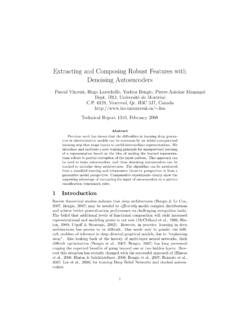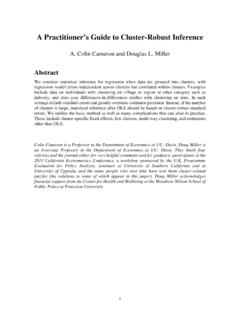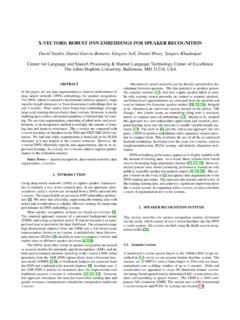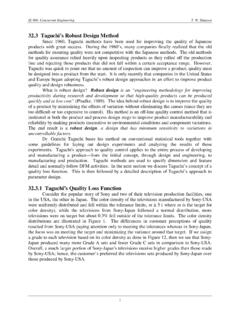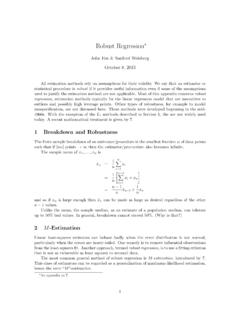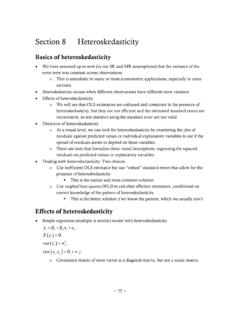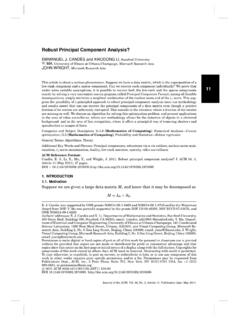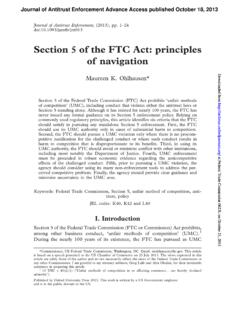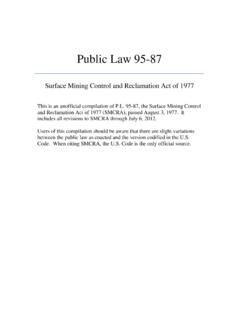Transcription of SURF: Speeded Up Robust Features
1 surf : Speeded Up Robust FeaturesHerbert Bay1, Tinne Tuytelaars2, and Luc Van Gool121 ETH Zurich{bay, Universiteit Leuven{ , this paper, we present a novel scale- and rotation-invariantinterest point detector and descriptor, coined surf ( Speeded Up Ro-bust Features ). It approximates or even outperforms previously proposedschemes with respect to repeatability, distinctiveness, and robustness, yetcan be computed and compared much is achieved by relying on integral images for image convolutions; bybuilding on the strengths of the leading existing detectors and descriptors(in casu, using a Hessian matrix-based measure for the detector, and adistribution-based descriptor); and by simplifying these methods to theessential.}}
2 This leads to a combination of novel detection, description, andmatching steps. The paper presents experimental results on a standardevaluation set, as well as on imagery obtained in the context of a real-lifeobject recognition application. Both show surf s strong IntroductionThe task of finding correspondences between two images of the same scene orobject is part of many computer vision applications. Camera calibration, 3 Dreconstruction, image registration, and object recognition are just a few. Thesearch for discrete image correspondences the goal of this work can be di-vided into three main steps. First, interest points are selected at distinctivelocations in the image, such as corners, blobs, and T-junctions.
3 The most valu-able property of an interest pointdetectoris its repeatability, whether itreliably finds the same interest points under different viewing conditions. Next,the neighbourhood of every interest point is represented by a feature vector. Thisdescriptorhas to be distinctive and, at the same time, Robust to noise, detec-tion errors, and geometric and photometric deformations. Finally, the descriptorvectors arematchedbetween different images. The matching is often based on adistance between the vectors, the Mahalanobis or Euclidean distance. Thedimension of the descriptor has a direct impact on the time this takes, and alower number of dimensions is therefore has been our goal to develop both a detector and descriptor, which incomparison to the state-of-the-art are faster to compute, while not sacrificingperformance.
4 In order to succeed, one has to strike a balance between the aboverequirements, like reducing the descriptor s dimension and complexity, whilekeeping it sufficiently Bay, T. Tuytelaars, and L. Van GoolA wide variety of detectors and descriptors have already been proposed in theliterature ( [1 6]). Also, detailed comparisons and evaluations on benchmark-ing datasets have been performed [7 9]. While constructing our fast detector anddescriptor, we built on the insights gained from this previous work in order to geta feel for what are the aspects contributing to performance. In our experimentson benchmark image sets as well as on a real object recognition application, theresulting detector and descriptor are not only faster, but also more distinctiveand equally working with local Features , a first issue that needs to be settled isthe required level of invariance.
5 Clearly, this depends on the expected geomet-ric and photometric deformations, which in turn are determined by the possiblechanges in viewing conditions. Here, we focus on scale and image rotation invari-ant detectors and descriptors. These seem to offer a good compromise betweenfeature complexity and robustness to commonly occurring deformations. Skew,anisotropic scaling, and perspective effects are assumed to be second-order ef-fects, that are covered to some degree by the overall robustness of the also claimed by Lowe [2], the additional complexity of full affine-invariant fea-tures often has a negative impact on their robustness and does not pay off, unlessreally large viewpoint changes are to be expected.
6 In some cases, even rotationinvariance can be left out, resulting in a scale-invariant only version of our de-scriptor, which we refer to as upright surf (U- surf ). Indeed, in quite a fewapplications, like mobile robot navigation or visual tourist guiding, the cameraoften only rotates about the vertical axis. The benefit of avoiding the overkill ofrotation invariance in such cases is not only increased speed, but also increaseddiscriminative power. Concerning the photometric deformations, we assume asimple linear model with a scale factor and offset. Notice that our detector anddescriptor don t use paper is organised as follows. Section 2 describes related work, on whichour results are founded.
7 Section 3 describes the interest point detection section 4, the new descriptor is presented. Finally, section 5 shows the exper-imental results and section 6 concludes the Related WorkInterest Point DetectorsThe most widely used detector probably is the Har-ris corner detector [10], proposed back in 1988, based on the eigenvalues of thesecond-moment matrix. However, Harris corners are not scale-invariant. Lin-deberg introduced the concept of automatic scale selection [1]. This allows todetect interest points in an image, each with their own characteristic scale. Heexperimented with both the determinant of the Hessian matrix as well as theLaplacian (which corresponds to the trace of the Hessian matrix) to detect blob-like structures.
8 Mikolajczyk and Schmid refined this method, creating robustand scale-invariant feature detectors with high repeatability, which they coinedHarris-Laplace and Hessian-Laplace [11]. They used a (scale-adapted) Harrismeasure or the determinant of the Hessian matrix to select the location, and theSURF: Speeded Up Robust Features3 Laplacian to select the scale. Focusing on speed, Lowe [12] approximated theLaplacian of Gaussian (LoG) by a Difference of Gaussians (DoG) other scale-invariant interest point detectors have been proposed. Ex-amples are the salient region detector proposed by Kadir and Brady [13], whichmaximises the entropy within the region, and the edge-based region detector pro-posed by Jurieet al.
9 [14]. They seem less amenable to acceleration though. Also,several affine-invariant feature detectors have been proposed that can cope withlonger viewpoint changes. However, these fall outside the scope of this studying the existing detectors and from published comparisons [15, 8],we can conclude that (1) Hessian-based detectors are more stable and repeat-able than their Harris-based counterparts. Using the determinant of the Hessianmatrix rather than its trace (the Laplacian) seems advantageous, as it fires lesson elongated, ill-localised structures. Also, (2) approximations like the DoG canbring speed at a low cost in terms of lost DescriptorsAn even larger variety of feature descriptors has been pro-posed, like Gaussian derivatives [16], moment invariants [17], complex Features [18,19], steerable filters [20], phase-based local Features [21], and descriptors repre-senting the distribution of smaller-scale Features within the interest point neigh-bourhood.
10 The latter, introduced by Lowe [2], have been shown to outperformthe others [7]. This can be explained by the fact that they capture a substantialamount of information about the spatial intensity patterns, while at the sametime being Robust to small deformations or localisation errors. The descriptorin [2], called SIFT for short, computes a histogram of local oriented gradientsaround the interest point and stores the bins in a 128-dimensional vector (8orientation bins for each of the 4 4 location bins).Various refinements on this basic scheme have been proposed. Ke and Suk-thankar [4] applied PCA on the gradient image. This PCA-SIFT yields a 36-dimensional descriptor which is fast for matching, but proved to be less distinc-tive than SIFT in a second comparative study by Mikolajczyket al.


